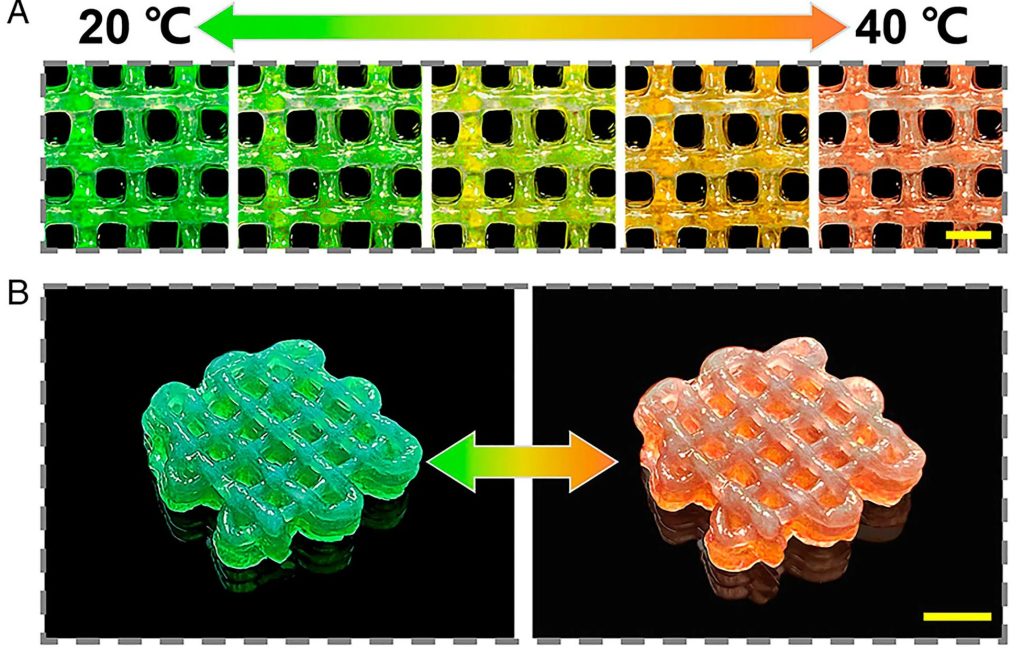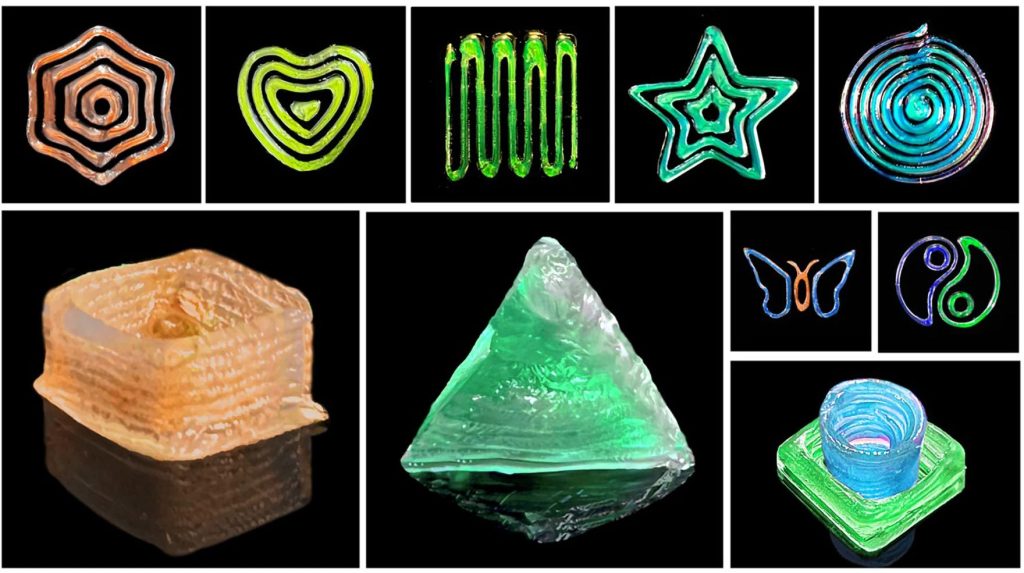A group of China-based researchers have developed a new way of adding color to 3D printed parts that’s said to result in much safer products than conventional dyeing or pigmentation.
The scientists’ approach revolves around a biocompatible ink they’ve developed, which yields parts capable of changing appearance through ‘structural coloration,’ in response to heat or light stimuli. Using their material, the team say it could be possible to produce everything from wearable bio-sensors to more child-safe toys.
“We believe that [our] cholesteric liquid crystal ink can shed light on next-generation environmentally friendly 3D photonic printing,” the team explain in their paper, published in this week’s Proceedings Of The National Academy Of Sciences journal. “The ink maintains a cholesteric liquid crystalline state that gives rise to the structural color.”

Overcoming the toxicity of dyeing
In the wider world, outside that of 3D printing, it’s relatively well-known that certain versions of consumer products such as hair and clothing dyes, can cause users to suffer from health issues. Sustainable clothing campaign group good on you goes so far as to say that in the latter, “many dyes used today are carcinogenic,” and while the notorious ‘azo dyes’ are banned in the EU, they’re often used elsewhere.
Researchers are interested in the pigments utilized to color 3D printing filaments. While the additives used for this purpose tend to vary from material to material, and like many things can be toxic in certain concentrations, especially if they agglomerate. This is partially why such extensive research goes into qualifying parts as food or skin-contact ‘safe,’ as there’s potential for cross-contamination in these areas.
That being said, in many cases, the coloration of fused filament fabrication 3D printed parts remains essential to their end-application, whether they be lifelike clinical models or desktop figures. The researchers at Fudan University in Shanghai, Southeast University in Nanjing and the University of Chinese Academy of Sciences, have therefore sought out a solution, and they’ve now found it in the natural world.
Specifically, the scientists have tried to replicate an effect known as structural coloration, which is used for everything from camouflage to attracting a mate, by animals such as butterflies and peacocks. In practice, the phenomenon creates the illusion of color via microscopically-structured surfaces, fine enough to interfere with visible light, often without the need for pigmentation to do so.
“When the material is illuminated, some of the light source’s wavelengths are reflected, creating what we see as color,” the study’s lead author Shang Luoran told the South China Morning Post. “In nature, this is how vibrant and metallic colors form without pigments on the wings of butterflies and insects, chameleons and some plants.”
“Structural coloration, based on the physics of color, is more stable and the color will not easily fade.”

A ‘structural coloration’ 3D printing ink
To formulate their novel 3D printing material, the researchers combined gelatin and hydrogel with hydroxypropyl cellulose (HPC) and cholesteric cellulose liquid crystals (CLCs). Using HPC as a ‘building block,’ the team found they were able to develop CLCs capable of creating bright and metallic colors, while the integration of a thermally-responsive hydrogel allowed this process to be ‘triggered’ by UV light.
Aiming to assess their material’s color-shifting capabilities, the scientists then went on to 3D print prototypes of varying shapes on flat surfaces, such as tinfoil and a laboratory bench. In each case, the parts are said to have changed appearance on-cue, thus the team now claim they’re looking into ways of improving on their formula, such as replacing its hydrogels with “naturally-derived alternatives.”
By doing so, the researchers say it could be possible to make their ink edible, providing it with a new potential market to tap into. The team are also investigating the possibility of using their material to manufacture parts on curved surfaces. In theory, this could enable the creation of complex parts such as those in childrens’ toys, which for obvious reasons, have to meet certain non-toxicity standards.
“Further modifying the formulation of the ink is expected,” concluded Luoran. “For now, objects are printed on flat surfaces. We hope the technology can be adapted to curved surfaces, like an apple, in different shapes in the future.”

Nature-inspired additive manufacturing
The Chinese scientists’ new material may well be unique, but it’s surprising how often the natural world seems to serve as a basis for 3D printing innovation. Just last year, scientists at the US Army’s Night Vision Lab managed to develop a unique 3D printed roller, capable of stamping the patterns that can make moths invisible onto military equipment.
Researchers at Zhejiang University, meanwhile, have turned to the cuttlefish as inspiration in their efforts to develop biomimetic cell-like structures with unique energy absorption capabilities. Ultra-lightweight, but still capable of withstanding up to 20,000 times their own weight in deformation, the team say that such parts could be applied within the creation of aircraft, armor, vehicles or construction.
Also taking inspiration from sea life, scientists at the National Taiwan University of Science and Technology have come up with new lattice 3D printing structures as well, which imitate the morphology of sea urchins. Using the creatures’ mechanically stable and load-bearing shape, the team there have been able to build more efficient support-free parts.
To stay up to date with the latest 3D printing news, don’t forget to subscribe to the 3D Printing Industry newsletter or follow us on Twitter or liking our page on Facebook.
For a deeper dive into additive manufacturing, you can now subscribe to our Youtube channel, featuring discussion, debriefs, and shots of 3D printing in-action.
Are you looking for a job in the additive manufacturing industry? Visit 3D Printing Jobs for a selection of roles in the industry.
Featured image shows a 3D printed part changing color under different thermal conditions. Image via the South China Morning post.


